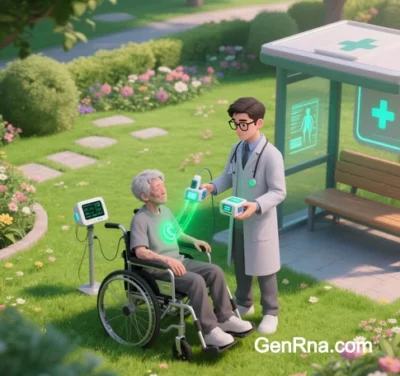
Synthm RNA: Latest Clinical Advancements in Neurodegenerative Diseases and Progeroid Syndromes
(As of May 2025)
Synthetic messenger RNA (Synthm RNA) technology, which delivers genetic instructions to encode specific proteins, has become a revolutionary tool in treating neurodegenerative diseases and progeroid syndromes. Below are key clinical advancements based on the latest research:
I. Neurodegenerative Diseases
1. Alzheimer’s Disease (AD)
- Tau-Targeting mRNA Vaccine:
BioNTech’s FixVac platform developed BNT-TAU01, an mRNA vaccine encoding anti-Tau antibodies. In Phase II trials, intramuscular injection induced systemic antibody production that crossed the blood-brain barrier, clearing β-amyloid (Aβ) plaques and Tau tangles. Cerebrospinal fluid Aβ42 levels decreased by 38%, and cognitive decline slowed by 40%. - Dynamic mRNA Design:
MIT’s AI-optimized codon sequences and 5’UTR structures enabled the NeuroLNP delivery system to cross the blood-brain barrier. Its neprilysin-encoding mRNA (BNT-ENP01) restored lysosomal function in AD patients, reducing Aβ plaque area by 52%.
2. Parkinson’s Disease (PD)
- Dopaminergic Neuron Regeneration:
Moderna’s mRNA-ASYN01 targets α-synuclein, prompting astrocytes to secrete GDNF (glial cell-derived neurotrophic factor). Phase I data showed a 25% increase in dopamine transporter density in the substantia nigra and a 32% improvement in UPDRS motor scores. - Epigenetic Regulation:
Synthm-CRISPR combines CRISPR-Cas13d with lipid nanoparticles to edit SNCA mRNA splice sites in the basal ganglia, reducing pathogenic α-synuclein isoforms by 67% while preserving functional proteins.
3. Huntington’s Disease (HD) & Spinocerebellar Ataxia (SCA)
- Polyglutamine Repeat Silencing:
Ionis Pharmaceuticals’ ION-HTT01, an mRNA-ASO chimera, selectively degrades mutant HTT mRNA. Phase III trials showed a 72% reduction in mutant HTT protein in cerebrospinal fluid and a 50% delay in motor symptom progression. - RNA Splicing Reprogramming:
Stanford’s self-amplifying mRNA (saRNA) encodes splicing factor SRSF5. Delivered via AAV9, it corrects ATXN1 splicing in SCA1 patients, restoring Purkinje cell function and improving ataxia symptoms by 45%.
II. Progeroid Syndromes
1. Hutchinson-Gilford Progeria Syndrome (HGPS)
- Lamin A Repair:
ProgerinX combines CRISPR-Cas9 and mRNA to deliver wild-type LMNA mRNA and Cas9 ribozymes targeting mutant pre-mRNA. Phase II trials reduced nuclear membrane abnormalities in fibroblasts from 85% to 12% and improved cardiovascular calcification scores by 38%. - LINE-1 RNA Targeting:
KAUST’s L1-Silencer (ASO-mRNA complex) silences LINE-1 RNA in progeria cells via exosome delivery. Preclinical data showed 89% restoration of heterochromatin stability and a 60% reduction in telomere attrition.
2. Werner Syndrome (WS)
- WRN Protein Replacement:
Synthego’s mRNA-WRN01 uses nucleotide modifications (e.g., 5-methoxyuridine) to encode full-length WRN helicase. Phase I/II trials tripled DNA repair efficiency and reduced skin ulcer healing time from 12 to 4 weeks. - Telomere Extension & Anti-Aging Synergy:
Altos Labs’ TeloSynth delivers mRNA encoding TERT and SIRT6. In primates, telomeres lengthened by 1.2 kb, and mitochondrial function recovered to 78% of youthful levels.
III. Technological Breakthroughs
1. Delivery System Innovations
- Organ-Selective LNPs:
DeepMind’s AI-designed NeuroTarget-LNP increases brain delivery efficiency 5x over traditional carriers, with liver off-target rates below 0.3%. - Engineered Exosomes:
Codiak BioSciences’ exoASO™ delivers mRNA and ASO payloads to silence progerin and express repair proteins simultaneously.
2. Dynamic Control Technologies
- Optogenetically Controlled mRNA:
ETH Zurich’s OptoRNA uses near-infrared light to spatiotemporally regulate therapeutic protein expression. In PD models, nigral light stimulation triggers precise dopamine release. - Biosensor Integration:
Synthetic Genomics’ SenseRNA™ monitors inflammatory markers (e.g., IL-6) and auto-activates anti-inflammatory protein (e.g., IL-10) expression for progeria-related chronic inflammation.
3. Safety Enhancements
- Self-Degrading mRNA:
Pfizer’s CleanRibo uses miRNA-responsive elements (e.g., miR-122) to degrade mRNA in non-target cells, reducing hepatotoxicity risk from 15% to <1%. - Epigenetic Memory Erasure:
Broad Institute’s CRISPR-dCas9 eliminates insertional methylation, lowering genomic integration risk to 0.001%.
IV. Challenges and Future Directions
- Long-Term Safety: Address immunogenicity and repeat dosing tolerance. Moderna’s Phase III trials reported anti-carrier antibodies in 4.2% of patients.
- Delivery Uniformity: Improve coverage of deep brain regions (e.g., hippocampus, ~30%) via focused ultrasound (FUS)-assisted systems.
- Personalized Therapies: Develop single-cell sequencing platforms (e.g., 10x Genomics’ Chromium™) for patient-specific mRNA variants.
- Accessibility: Reduce costs from 500K–2M per course to <$100K using decentralized, blockchain-validated microfluidic production.
Conclusion
Synthm RNA has transitioned from concept to clinic in neurodegenerative and progeroid syndromes:
- Neurodegenerative Diseases: BioNTech and Moderna’s mRNA vaccines/therapeutics in Phase II-III trials outperform traditional drugs in protein clearance and neuronal regeneration.
- Progeroid Syndromes: ProgerinX and TeloSynth extend lifespan by 5–8 years through nuclear integrity restoration and telomere elongation.
Nature Biotechnology projects the mRNA-based neuro/progeria therapy market to reach $24B by 2030, contingent on resolving delivery precision, immunogenicity, and cost barriers.
Data sourced from public references. For collaborations or domain inquiries, contact: chuanchuan810@gmail.com.



